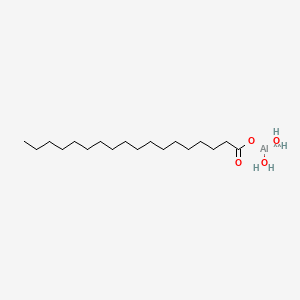Synopsis
Synopsis
0
API Suppliers
0
USDMF
0
CEP/COS
0
JDMF
0
EU WC
0
KDMF
0
NDC API
0
VMF
0
Listed Suppliers
0
EDQM
0
USP
0
JP
0
Others
0
FDF Dossiers
0
FDA Orange Book

0
Europe

0
Canada

0
Australia

0
South Africa

0
Listed Dossiers
DRUG PRODUCT COMPOSITIONS
0
US Patents
0
US Exclusivities
0
Health Canada Patents
US Medicaid
NA
Annual Reports
NA
Regulatory FDF Prices
NA
0
API
0
FDF
0
Data Compilation #PharmaFlow
0
Stock Recap #PipelineProspector
0
Weekly News Recap #Phispers
0
News #PharmaBuzz


1. Aluminum Tristearate
2. Ammonium Stearate
3. Calcium Stearate
4. Magnesium Stearate
5. Octadecanoic Acid
6. Sodium Stearate
7. Stearic Acid
8. Zinc Stearate
1. 7047-84-9
2. Dibasic Aluminum Stearate
3. Dihydroxyaluminum Stearate
4. Dihydroxy(stearato)aluminium
5. Dihydroxy(stearato)aluminum
6. Dihydroxyaluminium Stearate, Pure
7. Chebi:31197
8. Ncgc00160596-02
9. Aluminum, Monostearate
10. Aluminum, Dihydroxide Stearate
11. Einecs 230-325-5
12. Aluminum, Dihydroxy(stearato)-
13. Aluminum Dihydroxide Stearate
14. Unii-p9bc99461e
15. Aluminum Dextran
16. Aluminum Monostearate [jan:nf]
17. Stearic Acid Aluminum Dihydroxide Salt
18. Aluminum, Dihydroxy(octadecanoato-kappao)-
19. Aluminum, Dihydroxy(octadecanoato-.kappa.o)-
20. Schembl4101
21. Dsstox_cid_28623
22. Dsstox_rid_82893
23. Dsstox_gsid_48697
24. Chembl3185220
25. Dtxsid9048697
26. Dihydroxido(octadecanoato)aluminium
27. Aluminum Monostearate (jp17/nf)
28. Tox21_113090
29. Akos024319334
30. Db01375
31. Ncgc00160596-01
32. Ncgc00160596-03
33. Cas-7047-84-9
34. D01867
35. F20724
36. Sr-01000945248
37. Q4119955
38. Sr-01000945248-1
39. Aluminum Monostearate, Technical, ~75% (al), Powder
| Molecular Weight | 346.5 g/mol |
|---|---|
| Molecular Formula | C18H39AlO4 |
| Hydrogen Bond Donor Count | 2 |
| Hydrogen Bond Acceptor Count | 4 |
| Rotatable Bond Count | 18 |
| Exact Mass | 346.2663731 g/mol |
| Monoisotopic Mass | 346.2663731 g/mol |
| Topological Polar Surface Area | 28.3 Ų |
| Heavy Atom Count | 23 |
| Formal Charge | 0 |
| Complexity | 225 |
| Isotope Atom Count | 0 |
| Defined Atom Stereocenter Count | 0 |
| Undefined Atom Stereocenter Count | 0 |
| Defined Bond Stereocenter Count | 0 |
| Undefined Bond Stereocenter Count | 0 |
| Covalently Bonded Unit Count | 3 |
Antacids perform a neutralization reaction, ie. they buffer gastric acid, raising the pH to reduce acidity in the stomach. When gastric hydrochloric acid reaches the nerves in the gasitrointestinal mucosa, they signal pain to the central nervous system. This happens when these nerves are exposed, as in peptic ulcers. The gastric acid may also reach ulcers in the esophagus or the duodenum. Other mechanisms may contribute, such as the effect of aluminum ions inhibiting smooth muscle cell contraction and delaying gastric emptying. Aluminum is known to bind troponin C (a muscle protein) and to interfere with voltage-dependent calcium transport. Aluminum also binds to and inhibits the activity of mitochondrial voltage gated channels (VDAC).
ABOUT THIS PAGE
44
PharmaCompass offers a list of Aluminum Monostearate API API manufacturers, exporters & distributors, which can be sorted by GMP, USDMF, JDMF, KDMF, CEP (COS), WC, Price,and more, enabling you to easily find the right Aluminum Monostearate API manufacturer or Aluminum Monostearate API supplier for your needs.
Send us enquiries for free, and we will assist you in establishing a direct connection with your preferred Aluminum Monostearate API manufacturer or Aluminum Monostearate API supplier.
PharmaCompass also assists you with knowing the Aluminum Monostearate API API Price utilized in the formulation of products. Aluminum Monostearate API API Price is not always fixed or binding as the Aluminum Monostearate API Price is obtained through a variety of data sources. The Aluminum Monostearate API Price can also vary due to multiple factors, including market conditions, regulatory modifications, or negotiated pricing deals.
A Aluminum Monostearate API manufacturer is defined as any person or entity involved in the manufacture, preparation, processing, compounding or propagation of Aluminum Monostearate API, including repackagers and relabelers. The FDA regulates Aluminum Monostearate API manufacturers to ensure that their products comply with relevant laws and regulations and are safe and effective to use. Aluminum Monostearate API API Manufacturers are required to adhere to Good Manufacturing Practices (GMP) to ensure that their products are consistently manufactured to meet established quality criteria.
A Aluminum Monostearate API supplier is an individual or a company that provides Aluminum Monostearate API active pharmaceutical ingredient (API) or Aluminum Monostearate API finished formulations upon request. The Aluminum Monostearate API suppliers may include Aluminum Monostearate API API manufacturers, exporters, distributors and traders.
Aluminum Monostearate API Active pharmaceutical ingredient (API) is produced in GMP-certified manufacturing facility.
GMP stands for Good Manufacturing Practices, which is a system used in the pharmaceutical industry to make sure that goods are regularly produced and monitored in accordance with quality standards. The FDA’s current Good Manufacturing Practices requirements are referred to as cGMP or current GMP which indicates that the company follows the most recent GMP specifications. The World Health Organization (WHO) has its own set of GMP guidelines, called the WHO GMP. Different countries can also set their own guidelines for GMP like China (Chinese GMP) or the EU (EU GMP).
PharmaCompass offers a list of Aluminum Monostearate API GMP manufacturers, exporters & distributors, which can be sorted by USDMF, JDMF, KDMF, CEP (COS), WC, API price, and more, enabling you to easily find the right Aluminum Monostearate API GMP manufacturer or Aluminum Monostearate API GMP API supplier for your needs.
A Aluminum Monostearate API CoA (Certificate of Analysis) is a formal document that attests to Aluminum Monostearate API's compliance with Aluminum Monostearate API specifications and serves as a tool for batch-level quality control.
Aluminum Monostearate API CoA mostly includes findings from lab analyses of a specific batch. For each Aluminum Monostearate API CoA document that a company creates, the USFDA specifies specific requirements, such as supplier information, material identification, transportation data, evidence of conformity and signature data.
Aluminum Monostearate API may be tested according to a variety of international standards, such as European Pharmacopoeia (Aluminum Monostearate API EP), Aluminum Monostearate API JP (Japanese Pharmacopeia) and the US Pharmacopoeia (Aluminum Monostearate API USP).
